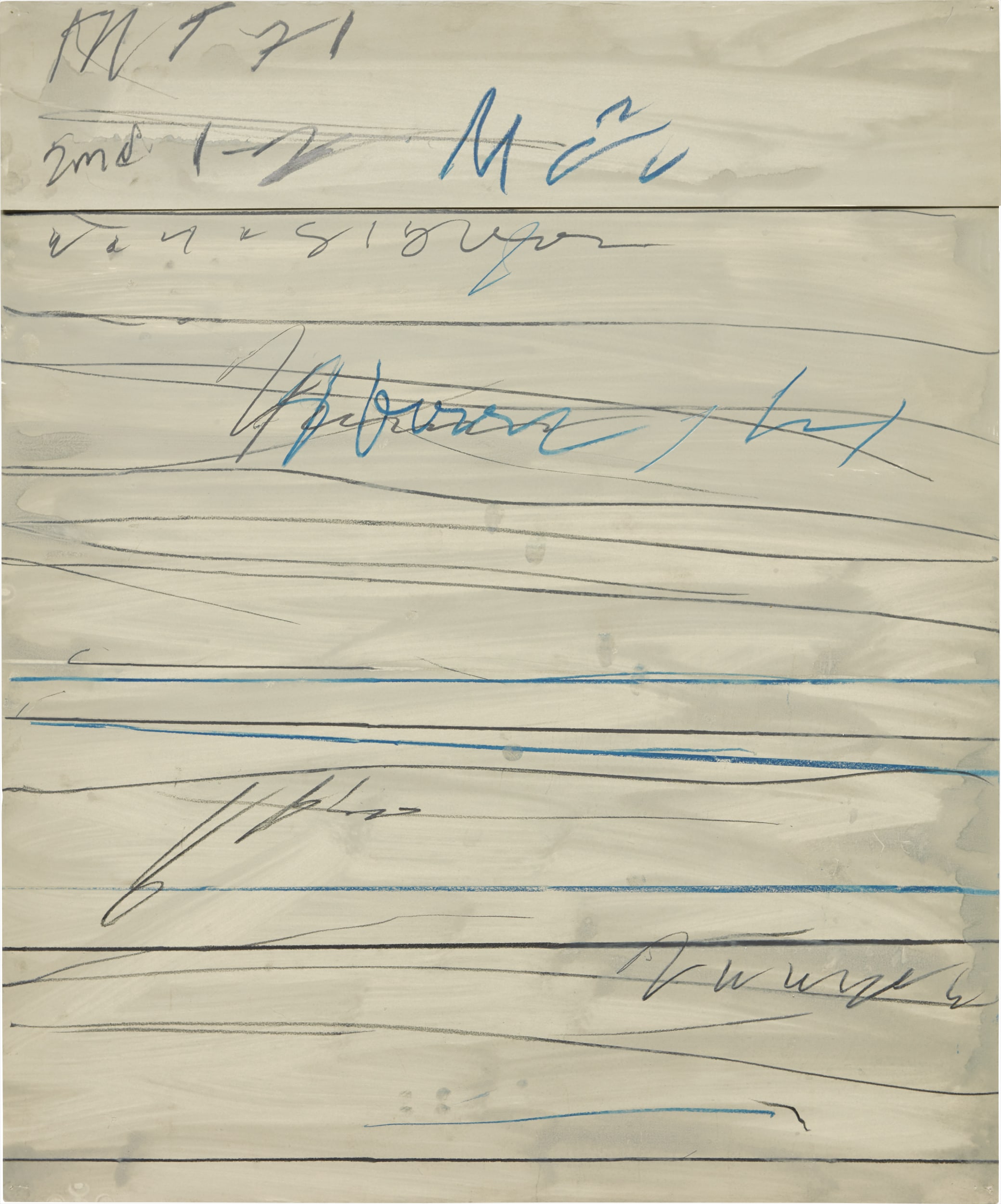

17
Cy Twombly
Untitled (Ramifications)
Full-Cataloguing
- Roland Barthes
Executed in 1971, Cy Twombly’s Untitled (Ramifications) epitomizes the iconic style the artist had been developing since the late 1960s. Just as Twombly embraced the act of repetitive mark-making in his blackboard works from 1967-1971, here too he rhythmically fills the pictorial ground with horizontal linear gestures that drift to the right – giving rise to a sense of continuous movement that is further enlivened by the cursive, semi-legible textual snippets that gently ripple across all 12 works that constitute the Ramification series. While formally calling to mind graphic notations, the flashes of bright marine blue crayon and watery swathes of oil paint imbue the work with atmospheric subtleties reminiscent of the Mediterranean sea that Twombly experienced during his summer sojourns in Capri, Italy.
With Untitled (Ramifications), Twombly continued to pursue the central tenets of his revolutionary graphic idiom that he first conceived in response to the ancient myths, history and Mediterranean landscape he encountered upon moving to Italy in the late 1950s. Challenging the traditional distinctions between painting and drawing, as well as text and image, Twombly pursued the dictum that the line “does not illustrate”, but rather, “is the sensation of its own realization” (Cy Twombly, “Signs”, L’Esperienza moderna, no. 2, August/September 1957, pp. 32–33). With works such as the present one, Twombly further developed the notion of how both painting and writing, as Roland Barthes observed, begin “with the same non-figurative, non-semantic gesture, a gesture that was simply rhythmical” (Roland Barthes, “La sociologie de l'art et sa vocation interdisciplinaire”, Coloquio/Artes, 1974, pp. 18-19).
Untitled (Ramifications) manifests the apex of a crucial shift in Twombly’s approach to mark-making that was set in motion in 1966 with works such as Problem I, II, III, Museum für Moderne Kunst, Frankfurt am Main. In contrast to Twombly’s sporadic, exuberant aesthetic and emotive use of color in his earlier white-ground work, the late 1960s and early 1970s were characterized by a more controlled and restrained style of repetitive, calligraphic marks on solid grounds. While echoing the minimalist aesthetics dominating the art world during this period, Twombly continued to pursue a highly idiosyncratic idiom that drew on the musical theory of Counterpoint, Palmer handwriting drills, André Masson's automatic drawing, Paul Klee's Pedagogical exercises, as well as Leonardo da Vinci’s cataclysmic Deluge drawings.
Untitled (Ramifications) and its related works were borne out of Twombly’s four-year engagement with his blackboard series, grey-ground works covered with terse, repetitive scrawls that he began in 1967 and would continue making until 1971. With its repetitive horizontal lines and rippling cursive scripture, Untitled (Ramifications) more specifically represents a powerful synthesis of two of the most seminal series from the 1970-1971 period: exploring the tension between the poles of minimalist linearity and organic mark-making, Twombly here expands upon the horizontal straight-edge lines from Treatise on the Veil (Second Version), 1970, The Menil Collection, Houston, and the free-flowing, cursive gestures from his Roman Note series from 1970 – allowing them to coalesce with a “sense of serene, oceanic dissolution, in a nebular cloud of great depth and infinite complexity” (Kirk Varnedoe, Twombly: A Retrospective, exh. cat., The Museum of Modern Art, New York, 1994, p. 43).
The driving linearity within Untitled (Ramifications) speaks of Twombly’s embrace of repetitive gestures to convey a sense of movement. Twombly’s “fascination for the forms of ‘lateral’ speed’” and 'language of flow' draws on such diverse forebears as Marcel Duchamp and Eadweard Muybridge, as well as the time/motion imagery of the late Futurist painters from the 1950s (Kirk Varnedoe, Cy Twombly: A Retrospective, exh. cat., Museum of Modern Art, New York, 1994, p. 41). Rather than emphasize the analytical, semi-scientific side of Futurism, as Kirk Varnedoe has shown, Twombly “responded more intuitively to the way the Futurists dispersed forms into linear sequences…neither geometry nor straight edges ever dominate the variations of the hand as it moves, from tremulous slowness to headline impulse to casual meander. Fluctuating individual energies invariable take precedence over rigorously systematic ideas” (Kirk Varnedoe, Cy Twombly: A Retrospective, exh. cat., Museum of Modern Art New York, 1994-1995, p. 41). Speaking to the bodily engagement with process behind each gesture in this way, Untitled (Ramifications) puts forward a poetic meditation on time and space.
Cy Twombly
American | B. 1928 D. 2011Cy Twombly emerged in the mid-1950s alongside New York artists Jasper Johns and Robert Rauschenberg. While at first developing a graffiti-like style influenced by Abstract Expressionist automatism–having notably studied under Franz Kline and Robert Motherwell at the legendary Black Mountain College between 1951 and 1952–Twombly was a prominent figure in the new generation of artists that challenged the abstract orthodoxy of the New York School. Twombly developed a highly unique pictorial language that found its purest expression upon his life-defining move to Rome in 1957. Simultaneously invoking classical history, poetry, mythology and his own contemporary lived experience, Twombly's visual idiom is distinguished by a remarkable vocabulary of signs and marks and the fusion of word and text.
Cy Twombly produced graffiti-like paintings that were inspired by the work of Willem de Kooning, Jackson Pollock and Robert Motherwell. His gestural forms of lines, drips and splattering were at first not well-received, but the artist later became known as the leader of the estrangement from the Abstract Expressionism movement. Full of energy and rawness, Twombly's pieces are reminiscent of childhood sketches and reveal his inspiration from mythology and poetry.